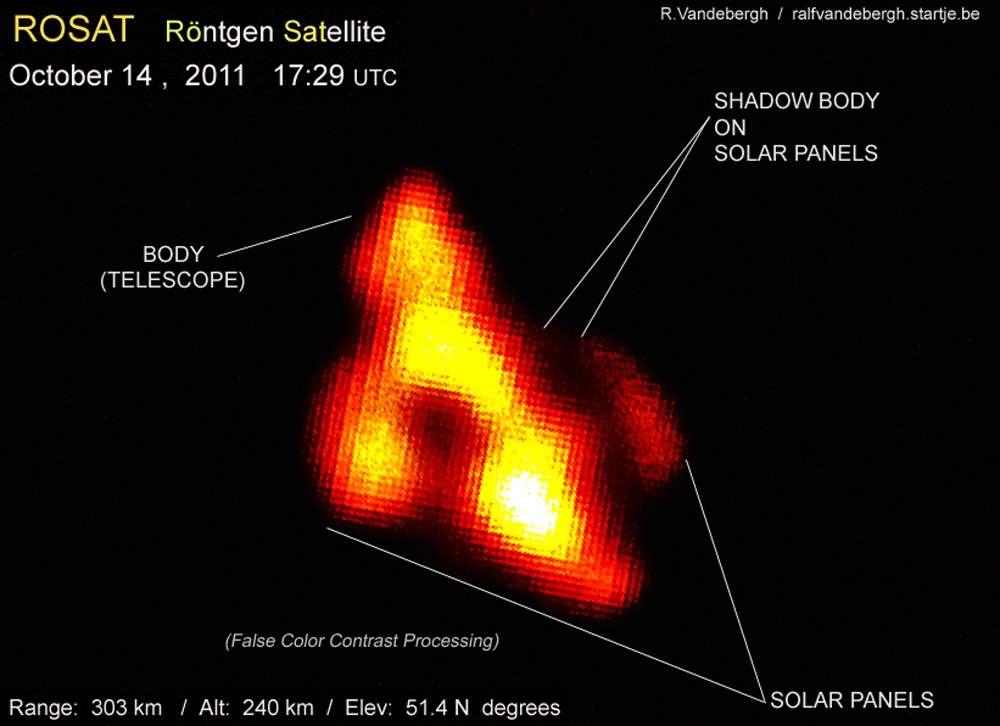What Are the Odds You'll Get Struck by the Falling ROSAT Satellite?

Not long after re-emerging en masse from our underground bunkers and panic rooms, having successfully avoided being squashed by a falling NASA satellite on Sept. 24, humanity has learned that the sky is falling yet again. Another huge piece of space debris, a 2.6-ton, defunct German telescope called the Roentgen Satellite (ROSAT), will crash back to Earth Saturday or Sunday (Oct. 22 or 23), and the chances it will hit someone are even greater this time around.
The odds are 1-in-2,000 that a chunk of ROSAT will strike a person. For the UARS satellite that fell into the southern Pacific Ocean in September, the odds were 1-in-3,200. According to Heiner Klinkrad, head of the European Space Agency's Orbital Debris Office, ROSAT poses a higher risk than UARS because more of its mass is expected to survive atmospheric re-entry and reach Earth's surface. [Photos: Germany's ROSAT Satellite Falling to Earth]
"The fact that the ROSAT re-entry risk estimate is higher than for UARS lies in the surviving mass, which, percentage-wise, is considerably higher for ROSAT than for UARS, and hence, the net mass reaching ground is higher for ROSAT than for UARS," Klinkrad told Life's Little Mysteries, a sister site to SPACE.com. "This is due to the ROSAT internal mirror assembly that is very resistant to [heat] during re-entry."
Typically, when a satellite crashes to Earth, only 20 to 40 percent of its mass survives; the rest burns up from heat generated by friction between the satellite and particles in the atmosphere, Klinkrad said. Because ROSAT's mirrors - which collected X-rays and extreme ultraviolet light emitted by celestial objects - resist heat, they reduce the percentage of the spacecraft that will burn up, and over half of the spacecraft's mass, about 1.7 tons of it, is expected to reach the surface. [If a Satellite Falls On Your Home, Who Pays for Repairs?]
According to scientists in NASA's orbital debris office at Johnson Space Center in Houston, calculating the risk of space debris hitting someone requires first working out how much debris makes landfall. Analysts then make a grid of how the human population is distributed around the globe. Oceans, deserts and the North and South poles are largely devoid of people, for example, whereas coastlines are brimming with them. In short, the analysts must figure out which patches of Earth have people standing on them.
Throwing in a few more minor details, such as the latitudes over which satellites spend most of their time orbiting - ROSAT will most likely fall between 53 degrees north and 53 degrees south latitudes - the scientists calculate how likely it is that a piece of space junk will strike the ground where a person happens to be. This time around, the odds are 1-in-2,000, and there's a one-in-several-trillion chance that not only will a person get hit, but that person will be you.
Two dead satellites have crashed to Earth in as many months, after years of gradually getting dragged down to lower and lower orbits. More will re-enter the atmosphere in the future. With this in mind, you may be interested to know the overall risk of getting struck in a given year, or in your lifetime.
Breaking space news, the latest updates on rocket launches, skywatching events and more!
"The annual risk of a single person to be severely injured by a re-entering piece of space debris is about 1 in 100 billion,” Klinkrad said. In the course of a 75-year lifetime, then, the odds of getting injured by space junk would be a little less than 1 in 1 billion. If this sounds scary, it probably shouldn't. By comparison, "the annual risk that a single person gets struck by a lightning is about a factor 60,000 higher, and the risk of a serious injury from a motor vehicle accident is about 27 million times higher than the risk associated with re-entry events."
This article was provided by Life's Little Mysteries, a sister site to SPACE. Follow us on Twitter @llmysteries, then join us on Facebook. Follow Natalie Wolchover on Twitter @nattyover.
Join our Space Forums to keep talking space on the latest missions, night sky and more! And if you have a news tip, correction or comment, let us know at: community@space.com.

Natalie Wolchover was a staff writer for Live Science and a contributor to Space.com from 2010 to 2012. She is now a senior writer and editor at Quanta Magazine, where she specializes in the physical sciences. Her writing has appeared in publications including Popular Science and Nature and has been included in The Best American Science and Nature Writing. She holds a bachelor's degree in physics from Tufts University and has studied physics at the University of California, Berkeley.

